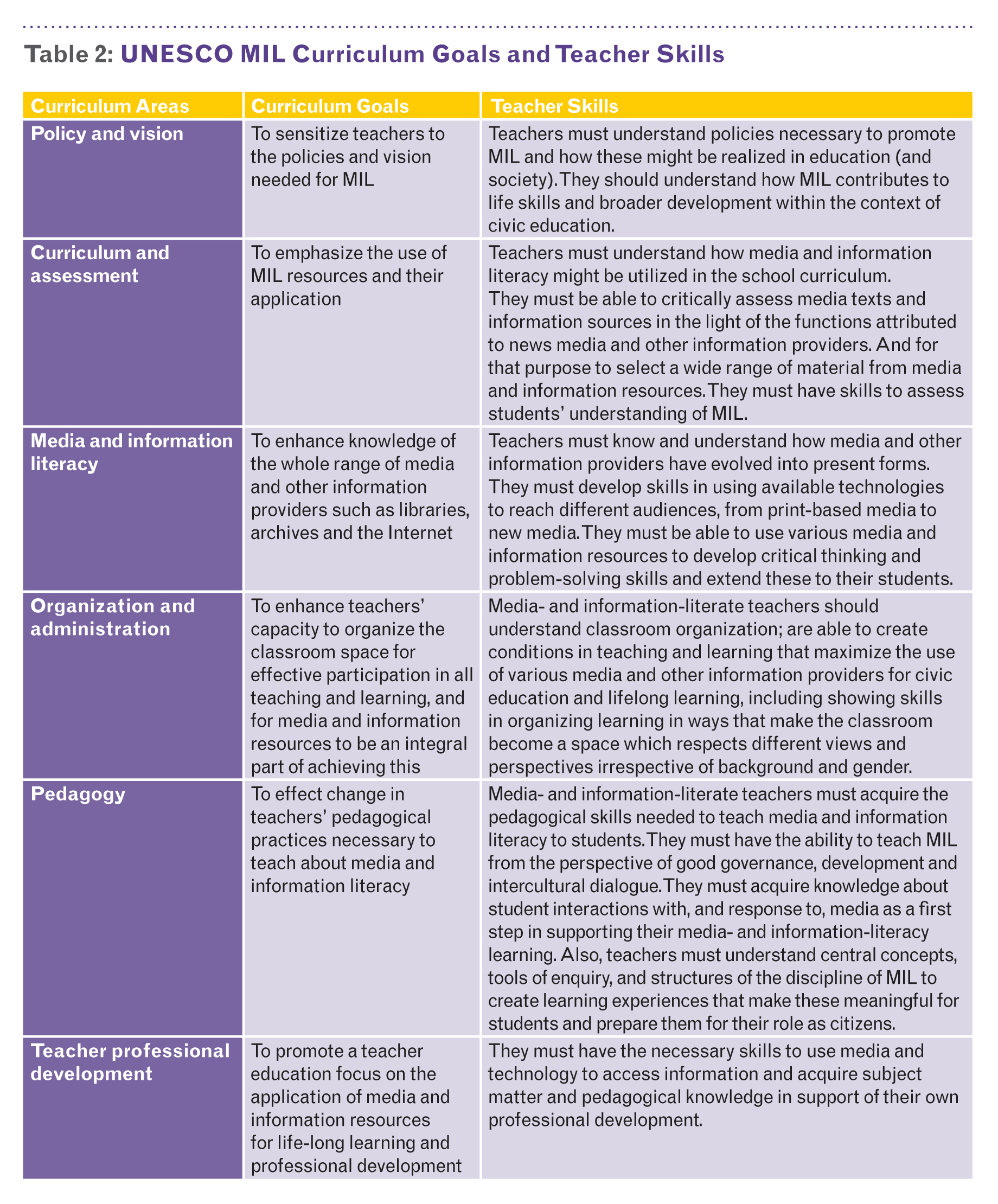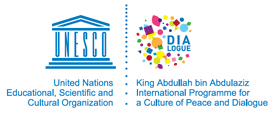Table 2 provides broad curriculum goals and associated teacher skills. These skills reflect the core competencies that teachers are expected to acquire and demonstrate under each of the elements of the MIL curriculum framework. In assessing the extent to which teachers have developed skills relevant to the curriculum areas, Table 2 provides what the overall expected outcomes should be.

This framework introduces nine core modules, two non-core modules and three non-core units for enriching the MIL curriculum. The modules provide an outline of content and activities that can be adapted by teachers and teacher education institutions to their respective countries. The following list of competencies, linked to the MIL curriculum
modules, units and themes, highlights specific knowledge and skills that teachers should acquire as they work their way through the modules. Where modules are selected for a particular programme of MIL for teacher education, they should cover most of these competencies.
COMPETENCIES
MIL Competency 1: Understanding the Role of Media and Information in Democracy
Modules in the MIL curriculum that are related to this competence include:Module 1, Citizenship, Freedom of Expression and Information, Access to Information, Democratic Discourse and Life-long Learning; Module 2, Understanding the News, Media and Information Ethics; Module 9, Communication, MIL and Learning – A Capstone ModuleThe MIL teacher will begin to become familiar with the functions of media and other information providers and understand their importance to citizenship and informed decision-making.
Outcomes of this competency should include the teacher’s ability to:
Identify, describe and evaluate the public service functions of media and other information providers in democratic societies.
Demonstrate understanding of key concepts such as freedom of expression, access to information and fundamental rights enshrined in Article 19 of the Universal Declaration of Human Rights (UDHR).
Interpret and describe the relationship between media and information literacy, citizenship and democracy.
Describe media pluralism, media and other information providers as platforms for intercultural dialogue and why these are important.
Describe editorial independence.
Explain journalism as a discipline of verification within a public service remit.
Describe media and information ethics, and be able to identify when these have been breached.
MIL Competency 2: Understanding Media Content and Its Uses
Modules in the MIL curriculum that are related to this competence include:
Module 2, Understanding the News, Media and Information Ethics; Module 3, Representation in Media and Information; Module 4, Languages in Media and Information; Module 10, Audience; Module 5, Advertising.
The MIL teacher will be able to demonstrate knowledge and understanding of the ways people use media in their personal and public lives, the relationships among citizens and media content, as well as the use of media for a variety of purposes.Outcomes of this competency should include the teacher’s ability to:
Interpret and make connections between media texts, context and values projected by media.
Use strategies to analyze stereotypes in media (e.g., recognize stereotypes that serve the interests of some groups in society at the expense of others; identify techniques used in visual media that perpetuate stereotypes).
Identify, analyze, and critique a variety of techniques used in advertising that are against international standards and codes of practice.
Explore representations, misrepresentations and lack of representation in media and information texts.
Understand and describe the characteristics and importance of public service broadcasters (PSB).
MIL Competency 3 : Accessing Information Effectively and Efficiently
Modules in the MIL curriculum that are related to this competence include:
Module 1, Citizenship, Freedom of Expression and Information, Access to Information, Democratic Discourse and Life-long Learning; Module 7, Internet Opportunities and Challenges; Module 8, Information Literacy and Library Skills. The MIL teacher will be able to determine the type of information needed for a particular task and access the information in an effective and efficient manner.
Outcomes of this competency should include the teacher’s ability to:
Select efficient and effective approaches for accessing information he/she requires for investigative or information retrieval purposes.
Identify keywords and related terms for accessing the information needed.
Identify a variety of types and formats of potential sources for information.
Describe criteria used to make information decisions and choices.
MIL Competency 4: Critically Evaluating Information and Information Sources
Modules in the MIL curriculum that are related to this competence include:
Module 3, Representation in Media and Information; Module 5, Advertising; Module 7, Internet Opportunities and Challenges; Module 8, Information Literacy and Library Skills; Module 9, Communication, MIL and Learning – A Capstone Module. The MIL teacher will be able to critically evaluate information and its sources and to incorporate selected information for problem-solving and analysis of ideas.
Outcomes of this competency should include the teacher’s ability to:
Demonstrate ability to examine and compare information from various sources in order to evaluate its reliability, validity, accuracy, authority, timeliness, and bias.
Use a variety of criteria (e.g., clarity, accuracy, effectiveness, bias, relevance of facts) to evaluate informational media (e.g. websites, documentaries, advertisements, news programmes).
Recognize prejudice, deception, or manipulation.
Recognize the cultural, social or other contexts within which the information was created and understand the impact of context on interpreting information.
Understand the range of media-related technologies and study the interaction of ideas.
Compare new knowledge with prior knowledge to determine the value added, contradictions, or other unique characteristics of the information.
Determine probable accuracy by questioning the source of data, limitations of the information gathering tools or strategies, and the reasonableness of the conclusions.
Use a range of strategies to interpret media texts (e.g. draw conclusions, make generalizations, synthesize materials viewed, refer to images or information in visual media to support point of view, deconstruct media to determine the underlying biases and decode the subtext).
MIL Competency 5: Applying New and Traditional Media Formats
Modules in the MIL curriculum that are related to this competence include:
Module 6, New and Traditional Media; Module 7, Internet Opportunities and Challenges; Module 3, Unit 5 Digital Editing and Computer Retouching; Module 4, Unit 4, Camera Shots and Angles Conveying Meaning
The MIL teacher will be able to understand the uses of digital technology, communication tools and networks for information gathering and decision-making.
Outcomes of this competency should include the teacher’s ability to:
Understand the basics of digital technology, communication tools and networks, and their usage in different contexts for different purposes.
Use a broad range of media ‘texts’ in order to express his/her own ideas through multiple forms of media (e.g. traditional print, electronic, digital, etc.).
Undertake basic online information searches.
Understand for what purposes youths use the Internet.
MIL Competency 6: Situating the Sociocultural Context of Media Content
Modules in the MIL curriculum that are related to this competence include:
Module 1, Citizenship, Freedom of Expression and Information, Access to Information, Democratic Discourse and Life-Long Leraning; Module 2, Understanding the News Media and Information Ethics; Module 3, Representation in Media and Information; Module 11, Media in the Global Context.
The MIL teacher will be able to demonstrate knowledge and understanding that media content is produced within social and cultural contexts.
Outcomes of this competency should include the teacher’s ability to:
Analyze and explain how the rules and expectations governing media genres can be manipulated for particular effects or purposes.
Produce media texts that present diverse perspectives and representations.
Describe media and other information providers as a platform for intercultural dialogue.
Demonstrate ability to critically evaluate local media content and the messages received or created by them for democratic citizenship and cultural diversity.
Understand how editing shapes meaning in visual media and their messages (e.g. omission of alternative perspectives; filtered or implied viewpoints; emphasis of specific ideas, etc.)
MIL Competency 7: Promoting MIL Among Students and Managing Required Changes
Modules in the MIL curriculum that are related to this competence include:
Module 1, Citizenship, Freedom of Expression and Information, Access to Information, Democratic Discourse and Life-long Learning; Module 9, Communication, MIL and Learning – A Capstone Module; Media and Information for Learning, Democratic Discourse; and all other modules. The MIL teacher will be able to use knowledge and skills acquired through his/her MIL training to promote media and information literacy among students and manage related changes in the school environment.
Outcomes of this competency should include the teacher’s ability to:
Understand how different students interpret and apply media products and events to their own lives.
Understand and use a variety of instructional activities to foster students’ skills in media and information literacy.
Demonstrate ability to help students select the most appropriate approaches (i.e., information retrieval systems) for accessing needed information.
Demonstrate ability to help students evaluate critically information and its sources while incorporating relevant information into their knowledge base.
Use knowledge of effective verbal, non-verbal, and media communication techniques to foster active enquiry, collaboration and free and open communication among students.
Understand and use formal and informal assessment strategies to develop knowledge and skills for critical reading, viewing and listening among students.
Use media and information literacy tools to foster a more participatory learning environment for students.
Use old or new media technologies to create a bond with school-based and out-of school learning, especially for students who are becoming alienated from school.
Use ICT in the classroom to help students discover ICT and media sources available to them and how to use them in their learning.
Use media and information literacy to widen participation in learning.
Use knowledge and skills acquired through his/her training to develop students’ skills in using media and library resources as tools for research and learning.
Use knowledge and skills acquired through his/her training to develop students’ skills in evaluating media and information and understanding ethical issues related to media and information literacy.

